
RAISING AWARENESS THROUGH EDUCATION
PROMOTING PREVENTION & EARLY DETECTION CAMPAIGNING FOR CHANGE
SKCIN: THE KAREN CLIFFORD SKIN CANCER CHARITY / REGISTERED CHARITY: 1150048

WE NEED YOUR HELP! PLEASE HELP US TO STOP SKIN CANCER TAKING MORE LIVES. WE ARE HUGELY GRATEFUL FOR YOUR SUPPORT.
Rarer Skin Cancers
about each type of skin cancer and what signs of change you should look out for - EARLY DETECTION IS VERY IMPORTANT!


Merkel cell carcinoma & rarer skin cancers
Find out about some rarer forms of skin cancer such as Merkel Cell Carcinoma, Cutaneous T-cell lymphoma and Kaposi's sarcoma
- Merkel cell carcinoma is a very rare disease in which malignant (cancer) cells form in the skin.
- Merkel cells are found in the top layer of the skin. These cells are very close to the nerve endings that receive the sensation of touch.
- Merkel cell carcinoma forms when the Merkel cells grow out of control.
- Merkel cell carcinoma starts most often in areas of skin exposed to the sun, especially the head and neck, as well as the arms, legs, and trunk.
- Merkel cell carcinoma tends to grow quickly and to metastasize (spread) at an early stage.
- It usually spreads first to nearby lymph nodes and then may spread to distant parts of the body, such as the lungs, brain, bones, or other organs.
What does Merkel cell carcinoma look like?
Merkel cell carcinoma usually appears as a single painless lump on sun-exposed skin.
Merkel cell carcinoma usually appears on sun-exposed skin as a single lump that is fast-growing, Painless, Firm and dome-shaped or raised, Red or violet in color.
This and other changes in the skin may be caused by Merkel cell carcinoma.
Seek immediate medical attention if you notice any of the above signs.
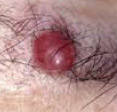
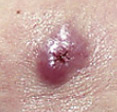
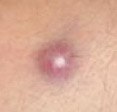
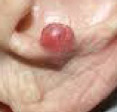
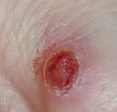
Risk factors for Merkel cell carcinoma include the following:
- Sun exposure and having a weak immune system can affect the risk of Merkel cell carcinoma.
- Being exposed to a lot of natural sunlight or artificial sunlight such as from tanning beds or psoralen and ultraviolet A (PUVA) therapy for psoriasis.
- Having an immune system weakened by disease, such as chronic lymphocytic leukemia or HIV infection.
- Taking drugs that make the immune system less active, such as after an organ transplant.
- Having a history of other types of cancer.
- Being older than 50 years, male, or having white skin.
Treatment for Merkel cell carcinoma
Treatment is with surgery or radiotherapy, or both.
This usually works well, but sometimes the cancer can come back in the same place.
The prognosis and treatment options depend on the following:
- The stage of the cancer, the size of the tumor and whether it has spread to the lymph nodes or other parts of the body.
- Where the cancer is in the body.
- Whether the cancer has just been diagnosed, or has recurred (come back).
- The patient's age and general health.
- How deeply the tumor has grown into the skin.
There are other less common types of skin cancer.
Added together, (including Merkel cell carcinoma) these types of rarer skin cancers make up about 1 out of every 100 (1%) of skin cancers diagnosed in the UK.
These rarer skin cancers include:
- Cutaneous T-cell lymphoma
- Kaposi's sarcoma
- Sebaceous gland carcinoma
- Dermatofibrosarcoma protuberans
Cutaneous T-cell lymphoma (CTCL)
Cutaneous T-cell lymphoma (CTCL) is a group of cancers that arise from a type of white blood cell called a T-cell lymphocyte that becomes cancerous and affects the skin. Most individuals are diagnosed after the age of 50 and men are twice as likely as women to be affected.
Signs and symptoms of CTCL:
Mycosis fungoides is the most common type of CTCL, and symptoms begin with the appearance of flat, red patches on the skin; in darker-skinned individuals, these may appear as either very light or very dark patches.
The patches tend to be very itchy, and may be dry and scaly.
Some areas of skin may become hard and elevated (called plaques).
In advanced cases, tumours may develop and skin folds can become thickened.
Treatment of CTCL:
There is a wide variety of chemotherapy drugs, immunotherapy (for example, interferon), and targeted drugs (for example, Denileukin Diftitox or Ontak) now available to treat CTCL.
Kaposi's Sarcoma (KS)
Kaposi sarcoma (KS) is a cancer that develops from the cells that line lymph or blood vessels and is caused by the Kaposi Sarcoma Herpesvirus (KSHV).
This type of skin cancer is more likely to develop in patients with the Human Immunodeficiency Virus (HIV), the virus that causes AIDS, but transplant recipients are another susceptible group.
Signs and symptoms of Kaposi's sarcoma
The appearance of Kaposi's sarcoma is purple, red, or brown blotches or tumours on the skin.
These can cause painful swelling, especially in the legs, groin area, or around the eyes.
KS can cause serious problems, or even become life threatening when the lesions are in the lungs, liver, or digestive tract.
Treatment of Kaposi's Sarcoma
Treatment has significantly improved in recent decades and now includes highly active antiretroviral therapy (HAART) to treat AIDS patients with KS, as well as topical creams, surgical removal, cryotherapy (freezing with liquid nitrogen), and chemotherapy.
Sebaceous Gland Carcinoma (SGC)
Sebaceous gland carcinoma (SGC) is a very rare, aggressive cancer originating in the oil glands in the skin. This type of skin cancer is most often found in women over 70 years of age.
About 75% of cases are diagnosed around the eye but can has also be found elsewhere on the head, neck, trunk, or in the genital area.
SGC is often slow growing and only spreads to other parts of the body in 1 out of every 5 cases.
Treatments available include surgery and radiation therapy.
Dermatofibrosarcoma Protuberans (DFSP)
Dermatofibrosarcoma protuberans (DFSP) is an uncommon type of tumour.
It is caused by a genetic mutation that results in the overproduction of a molecule called platelet-derived growth factor.
It begins as a hard nodule, grows slowly, and rarely spreads to other parts of the body.
These tumours are usually found in the skin's dermis (the inner layer of the two main layers of tissue that make up the skin) of the limbs or trunk of the body.
Treatment options include surgery, radiation therapy, and a newer drug called imatinib (Gleevec).
DFSP is frequently misdiagnosed or treated incompletely, so it is important to find a dermatologist with specific experience in treating this type of cancer.
THE EARLY DETECTION OF SKIN CANCER CAN REDUCE YOUR RISK OF POTENTIAL DISFIGURMENT OR EVEN DEATH.
Make sure you check your skin thoroughly at least once a month for signs of change.
Remember what to look out for when checking your skin - download and print off our early detection fact sheet.
DOWNLOAD NOWREMEMBER: If you are worried or uncertain about any suspicious patch, lump, mole or lesion - go to your GP and seek professional advice from a skin specialist or dematologist immediately.
REMEMBER: PREVENTION IS BETTER THAN CURE!
Always use the
Five S's of Sun
Safety & never allow
your skin to burn!







